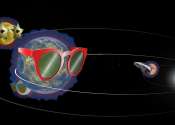How magnetism could help explain the Earth-moon system's formation
There are several theories about how Earth and its moon were formed, most involving a giant impact. Now scientists at the University of Leeds and the University of Chicago have analyzed the dynamics of fluids and electrically ...









